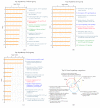Gene Expression Profiling Confirms the Dosage-Dependent Additive Neuroprotective Effects of Jasminoidin in a Mouse Model of Ischemia-Reperfusion Injury
- PMID: 29862259
- PMCID: PMC5976973
- DOI: 10.1155/2018/2785636
Gene Expression Profiling Confirms the Dosage-Dependent Additive Neuroprotective Effects of Jasminoidin in a Mouse Model of Ischemia-Reperfusion Injury
Abstract
Recent evidence demonstrates that a double dose of Jasminoidin (2·JA) is more effective than Jasminoidin (JA) in cerebral ischemia therapy, but its dosage-effect mechanisms are unclear. In this study, the software GeneGo MetaCore was used to perform pathway analysis of the differentially expressed genes obtained in microarrays of mice belonging to four groups (Sham, Vehicle, JA, and 2·JA), aiming to elucidate differences in JA and 2·JA's dose-dependent pharmacological mechanism from a system's perspective. The top 10 enriched pathways in the 2·JA condition were mainly involved in neuroprotection (70% of the pathways), apoptosis and survival (40%), and anti-inflammation (20%), while JA induced pathways were mainly involved in apoptosis and survival (60%), anti-inflammation (20%), and lipid metabolism (20%). Regarding shared pathways and processes, 3, 1, and 3 pathways overlapped between the Vehicle and JA, Vehicle and 2·JA, and JA and 2·JA conditions, respectively; for the top ten overlapped processes these numbers were 3, 0, and 4, respectively. The common pathways and processes in the 2·JA condition included differentially expressed genes significantly different from those in JA. Seven representative pathways were only activated by 2·JA, such as Gamma-Secretase regulation of neuronal cell development. Process network comparison indicated that significant nodes, such as alpha-MSH, ACTH, PKR1, and WNT, were involved in the pharmacological mechanism of 2·JA. Function distribution was different between JA and 2·JA groups, indicating a dosage additive mechanism in cerebral ischemia treatment. Such systemic approach based on whole-genome multiple pathways and networks may provide an effective and alternative approach to identify alterations underlining dosage-dependent therapeutic benefits of pharmacological compounds on complex disease processes.
Figures







Similar articles
-
Vertical and Horizontal Convergences of Targeting Pathways in Combination Therapy with Baicalin and Jasminoidin for Cerebral Ischemia.CNS Neurol Disord Drug Targets. 2016;15(6):740-50. doi: 10.2174/1871527315666160321111053. CNS Neurol Disord Drug Targets. 2016. PMID: 26996167
-
Variation of pathways and network profiles reveals the differential pharmacological mechanisms of each effective component to treat middle cerebral artery ischemia-reperfusion mice.Exp Biol Med (Maywood). 2016 Jan;241(1):79-89. doi: 10.1177/1535370215594584. Epub 2015 Jul 12. Exp Biol Med (Maywood). 2016. PMID: 26168995 Free PMC article.
-
Variations in target gene expression and pathway profiles in the mouse hippocampus following treatment with different effective compounds for ischemia-reperfusion injury.Naunyn Schmiedebergs Arch Pharmacol. 2012 Aug;385(8):797-806. doi: 10.1007/s00210-012-0743-1. Epub 2012 May 24. Naunyn Schmiedebergs Arch Pharmacol. 2012. PMID: 22622953
-
Genome Analysis Reveals a Synergistic Mechanism of Ursodeoxycholic Acid and Jasminoidin in Mice Brain Repair After Ischemia/Reperfusion: Crosstalk Among Muti-Pathways.Front Pharmacol. 2019 Dec 12;10:1383. doi: 10.3389/fphar.2019.01383. eCollection 2019. Front Pharmacol. 2019. PMID: 31920636 Free PMC article.
-
[Retinal neuronal cell death: molecular mechanism and neuroprotection].Nippon Ganka Gakkai Zasshi. 2001 Dec;105(12):884-902. Nippon Ganka Gakkai Zasshi. 2001. PMID: 11802459 Review. Japanese.
Cited by
-
23-Hydroxytormentic acid reduces cerebral ischemia/reperfusion damage in rats through anti-apoptotic, antioxidant, and anti-inflammatory mechanisms.Naunyn Schmiedebergs Arch Pharmacol. 2021 May;394(5):1045-1054. doi: 10.1007/s00210-020-02038-2. Epub 2021 Jan 4. Naunyn Schmiedebergs Arch Pharmacol. 2021. PMID: 33394135
-
Divergence and Convergence of Cerebral Ischemia Pathways Profile Deciphers Differential Pure Additive and Synergistic Mechanisms.Front Pharmacol. 2020 Feb 25;11:80. doi: 10.3389/fphar.2020.00080. eCollection 2020. Front Pharmacol. 2020. PMID: 32161541 Free PMC article.
References
-
- Jing Z., ZHou C., Wang Z., et al. Principal component analysis of gene expression of baicalin, jasminoidin and their combination in experimental stroke. 2010;51:164–167.
-
- Wang Z., Ying K., Zhang Z. J., et al. The effect of Baicalin on gene expression profile in rat brain of focal cerebral ischemia. 2004;29:83–86. - PubMed
MeSH terms
Substances
LinkOut - more resources
Full Text Sources
Other Literature Sources

